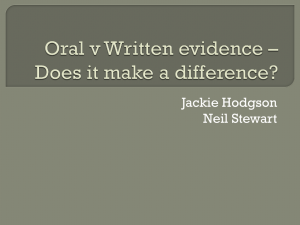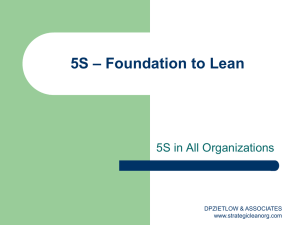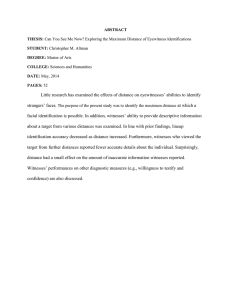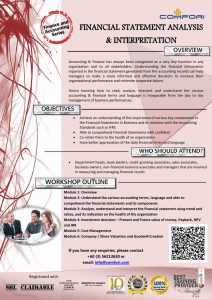Pretrial Litigation: Simulation Style Prof. Anne Alexander
advertisement
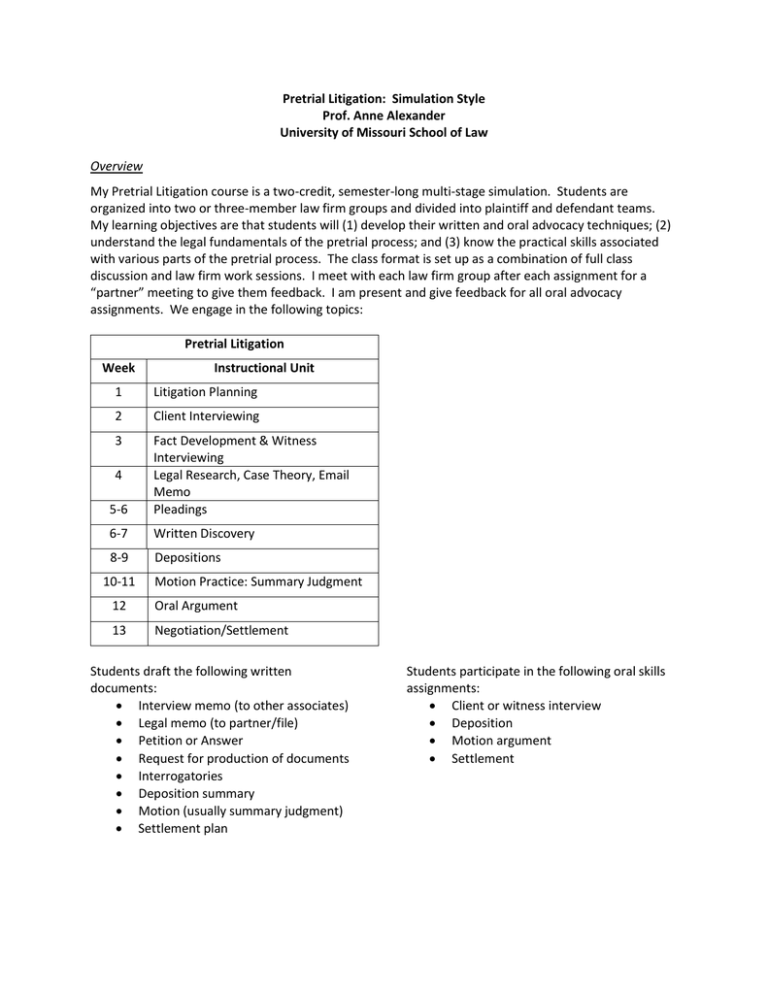
Pretrial Litigation: Simulation Style Prof. Anne Alexander University of Missouri School of Law Overview My Pretrial Litigation course is a two-credit, semester-long multi-stage simulation. Students are organized into two or three-member law firm groups and divided into plaintiff and defendant teams. My learning objectives are that students will (1) develop their written and oral advocacy techniques; (2) understand the legal fundamentals of the pretrial process; and (3) know the practical skills associated with various parts of the pretrial process. The class format is set up as a combination of full class discussion and law firm work sessions. I meet with each law firm group after each assignment for a “partner” meeting to give them feedback. I am present and give feedback for all oral advocacy assignments. We engage in the following topics: Pretrial Litigation Week Instructional Unit 1 Litigation Planning 2 Client Interviewing 3 5-6 Fact Development & Witness Interviewing Legal Research, Case Theory, Email Memo Pleadings 6-7 Written Discovery 8-9 Depositions 4 10-11 Motion Practice: Summary Judgment 12 Oral Argument 13 Negotiation/Settlement Students draft the following written documents: Interview memo (to other associates) Legal memo (to partner/file) Petition or Answer Request for production of documents Interrogatories Deposition summary Motion (usually summary judgment) Settlement plan Students participate in the following oral skills assignments: Client or witness interview Deposition Motion argument Settlement The Structure Litigation Planning. On the first day of class, associates are told the basic legal issue (without facts) and must choose law firm partners and sides. For example, I may state, “This problem will deal with teacher speech and when it is protected (and when it is not protected) under the First Amendment.” Then associates divide into two rooms in their respective groups: plaintiff’s counsel and defendant’s counsel. I give them a one-page partner memo that reflects a very basic client intake call, and I float between the two rooms giving minimal background information and fielding basic questions. However, for most factual questions I tell associates that we will have to gather the answers by doing factual investigation – interviewing the client and witnesses. For legal questions, I instruct the associates to create a research log and begin the basic secondary-source research necessary to understand the legal framework. Students are sometimes surprised that they will not receive all the facts in a tidy package. Students spend the first week of class doing basic legal research and preparing for their client interviews. Client and Witness Interviews. The total number of clients and witnesses varies between six and eight depending on the class size; plaintiff’s and defendant’s counsel each have the same number of witnesses available to them. During the second week of class, associates interview the client. Interviewing techniques are demonstrated and discussed prior to the interviews. The questions are informed by the basic facts and their initial legal research. During the third week of class, students interview supportive witnesses. The interviews are scheduled such that each two or three-member law firm conducts one interview during the second and third week of classes. Other associates may attend (but not ask questions) at interviews of their client or supportive witnesses. I attend all interviews and provide procedural and substantive critique after the interview concludes. Within 24 hours, students must circulate a memo to their fellow associates memorializing the information gathered during the interview. As the assigning partner, I revise and edit these memos. The memos are placed in password protected case file on TWEN. Email Memorandum. Flush with new factual information and documents, the associates begin legal research in earnest. They now have enough factual information to evaluate the legal merits of their client’s case. By the end of fourth week of classes, each law firm group submits an email memorandum in which they articulate the factual background and the potential legal causes of action and defenses. Associates are encouraged to present the case objectively and reflect on what further information they may need. Associates are also expected to evaluate the merits and risks of their client’s position. I have a partner meeting with each law firm group to discuss the merits of the case and provide oral feedback on their memorandum. Pleadings. The exchange of pleadings commences the official legal action in our simulated case. Prior to filing pleadings, we meet and discuss the potential different paths of pretrial litigation. This is one of several points in the semester where I emphasize that although the simulation is linear, most pretrial litigation is not linear. During week five, plaintiff’s attorneys draft and file a Missouri petition. During week six, defendant’s attorneys draft and file an answer. Again, we discuss potential courses of action, and then I articulate simulation rules, including that (1) all motions to dismiss are denied, and (2) all motions for removal are denied. I do allow friendly amendments to both the petition and answer. This keeps all law firm groups moving forward in the simulation. Written Discovery. During weeks six and seven, associates exchange interrogatory requests and requests for production of documents. In the past, I have also required associates to draft responses to these requests, but I have decided that the time required to draft these responses is better spent elsewhere. Instead, I draft responses and also place the responsive documents into the case file on TWEN. In theory, it may be possible for a law firm group to write poor requests and miss discovery of a pertinent document; in practice, all pertinent documents are provided because the requests are written collaboratively and with my feedback. Written discovery also provides a great opportunity for a discussion and reminder of work product protections as each law firm group grapples with whether their witness memo and email memorandum are discoverable. Depositions. Depositions are one of the most anticipated events of the semester. Associates prepare for depositions through robust class discussion, watching demonstrations, watching videos of depositions, and reading transcripts of depositions. Each law firm group deposes one client or witness and also serves as defending counsel for another deposition. The depositions are scheduled throughout the ninth week of classes and last approximately one hour. Associates may attend any deposition, but may speak only when they are counsel of record. I attend all depositions and provide procedural and substantive feedback for the deposing and defending attorneys after the conclusion of each deposition. Within 48 hours of the deposition, the deposing attorneys must (1) draft a summary of the deposition, (2) obtain approval from defending attorneys regarding the content, and (3) circulate the deposition summary to all counsel. In simulation world, this summary serves as the deposition transcript. Summary Judgment. At this point in the semester, I tell all associates that discovery is closed, and each team evaluates their case. During week 10, defendant’s counsel files a motion for summary judgment, and during week 11, plaintiff’s counsel files a response. During week 12, I serve as judge and hear oral argument on the motions and responses. Oral argument is scheduled throughout the week; each court session involves one plaintiff’s attorney and one defendant’s attorney. This is a closed court session, and other associates may not attend. Following all oral arguments, I take the matter under advisement. Settlement. With their case under advisement, I encourage associates to consider meeting for settlement negotiations lest they be stuck arguing the case in trial practice the following semester. During week 13, each law firm group meets briefly with their client to determine the contours of potential settlement. At the end of that meeting, the associates are given authority to act on behalf of their client. The students draft a settlement proposal document and meet with opposing counsel. Associates have 40 minutes to negotiate and potentially settle. Settlement outcomes are variable. Witnesses Finding witnesses for a semester-long simulation is always a challenge. I have tried different approaches, with mixed success. I usually need between six to eight witnesses for classes with enrollment between 13 and 18 students. At a minimum, these witnesses need to be available for an initial interview and for a deposition. Including background reading, this is approximately a two hour time commitment. However, in order to increase the realism of the course, I also allow students to email the client and other witnesses throughout the term. I answer each of these questions as though I am the witness. I have tried four different approaches for recruiting volunteer witnesses. First, I have used my own family and personal friends as witnesses. This approach yielded the most prepared witnesses; however, as non-lawyers those witnesses often made subtle changes to the material that had long-reaching effects. For example, one semester I planned a false imprisonment problem and the witness playing the plaintiff stated affirmatively that the security guard touched her arm and may have left bruises, thereby changing the simulation to a battery problem. Second, I have asked first year law students to volunteer. This approach yielded less prepared and more nervous witnesses. Additionally, this created a problem when using the same simulation materials the following year; the potential for a future student to have access to confidential witness material was not ideal. Third, I have requested that each pretrial student provide a witness. This caused scheduling difficulties, and witnesses often had a vested interest in helping “their” student. Finally, I have served as my own witnesses. This is exhausting, but rewarding. As the witness, I am able to make pedagogical changes mid-interview or mid-deposition. The drawback to this approach is that it is difficult to both play a witness and take notes to give proper feedback. In the future I will continue to use some combination of these methods and hope for the funds to hire actors. The Simulation In the past, I have used various sources for my simulation materials. However, for Spring 2015, I developed a new legal problem and drafted the accompanying witness instructions and supporting documents. This semester’s simulation has been successful, in part because of my own investment and ownership of the legal scenario. It has also been much more work. The major issue is whether a teacher’s Facebook posts are protected speech. Payton Lee, a local science teacher, was disappointed with the outcome of a school district committee meeting. She expressed her disappointment on Facebook—at times during her lunch break at school. She also posted on a student’s parent’s Facebook page. The school district terminated Ms. Lee for insubordination and failure to follow the school board’s social media policy. The plaintiff’s position is that she was fired for speech in a public forum on a matter of public concern. Plaintiff also argues that defendant’s social media policy is unconstitutional. The defendant’s position is that plaintiff’s Facebook posts were made in her official capacity as a teacher – the posts related to committee work she was assigned to as part of her job, one post was a communication with a parent, and one post was made during the school work day. The materials that I prepared for this simulation include six different witness instructions, plaintiff/defendant partner memos, Facebook posts, a social media policy, emails gathered during discovery, global warming science standards and modifications, school board minutes, the termination letter, and the teacher contract. I hope to expand the case file in future semesters. *** My syllabus for the Pretrial Litigation simulation course is posted here, and I would be happy to discuss similar courses and share materials. Please feel free to contact me at alexanderam@missouri.edu.

